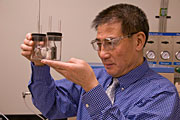- Number 292 |
- August 4, 2009
New electrode for improved lithium-ion battery performance

Dr. Ming Au developed
nanostructured anodes.
A new kind of anode developed at DOE's Savannah River National Laboratory is expected to increase the energy density of lithium-ion batteries four-fold—or enough to enable the battery to power an electric car for 300 miles on a single charge.
The energy storage capacity of today’s lithium-ion batteries is limited by the widely used graphite anode, in which lithium (Li) ions are sandwiched into the carbon layer structure, with every six carbon atoms accommodating one Li atom. This structure gives the graphite anode a theoretical capacity of 372mAh/g. Reaching the 300-mile goal will require increasing the energy density 3-4 times that of the traditional anode.
SRNL’s Dr. Ming Au developed nanostructured anodes that not only reach the desired increase in energy density, but use a production method that eliminates safety and environmental concerns presented by standard fabrication of carbon based anodes. The next challenge will be to sustain that energy density through multiple charge-discharge cycles.
His solution uses nanorods of various metals and metal oxides directly formed with the current collectors. Although tiny, these nanorods have the advantage of large surface areas for lithium ions to access, which means they can bind a higher number of lithium cations than the conventional graphite design.
Studies of these formations have shown that numerous inexpensive metals and metal oxides can be considered for nanorod formations to elevate charge capacities of the anodes in lithium-ion batteries. Further studies are ongoing to explore other nanostructure such as nanoporous hollow spheres of metals and metal oxides, understand the mechanism of lithium reaction in anode and sustain the high energy density through multiple charge-discharge cycles.
Submitted by DOE's Savannah River National Laboratory
